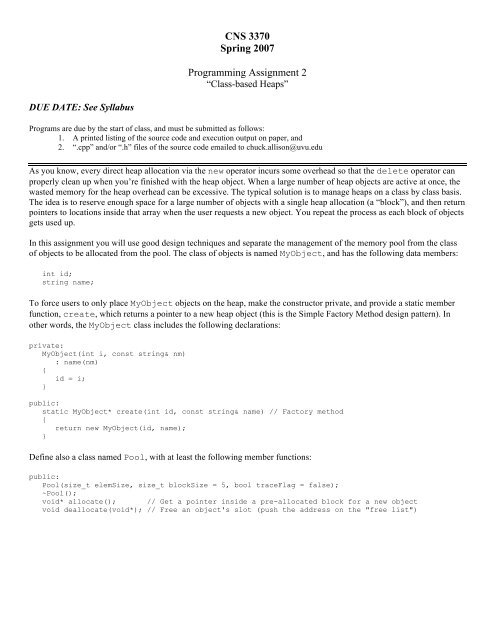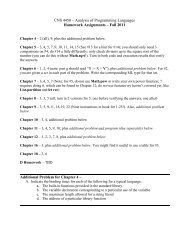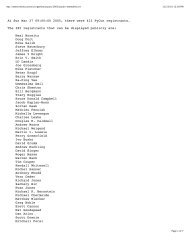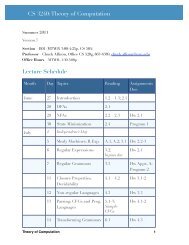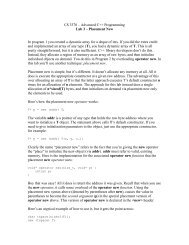Program 2
Program 2
Program 2
Create successful ePaper yourself
Turn your PDF publications into a flip-book with our unique Google optimized e-Paper software.
CNS 3370<br />
Spring 2007<br />
<strong>Program</strong>ming Assignment 2<br />
“Class-based Heaps”<br />
DUE DATE: See Syllabus<br />
<strong>Program</strong>s are due by the start of class, and must be submitted as follows:<br />
1. A printed listing of the source code and execution output on paper, and<br />
2. “.cpp” and/or “.h” files of the source code emailed to chuck.allison@uvu.edu<br />
As you know, every direct heap allocation via the new operator incurs some overhead so that the delete operator can<br />
properly clean up when you’re finished with the heap object. When a large number of heap objects are active at once, the<br />
wasted memory for the heap overhead can be excessive. The typical solution is to manage heaps on a class by class basis.<br />
The idea is to reserve enough space for a large number of objects with a single heap allocation (a “block”), and then return<br />
pointers to locations inside that array when the user requests a new object. You repeat the process as each block of objects<br />
gets used up.<br />
In this assignment you will use good design techniques and separate the management of the memory pool from the class<br />
of objects to be allocated from the pool. The class of objects is named MyObject, and has the following data members:<br />
int id;<br />
string name;<br />
To force users to only place MyObject objects on the heap, make the constructor private, and provide a static member<br />
function, create, which returns a pointer to a new heap object (this is the Simple Factory Method design pattern). In<br />
other words, the MyObject class includes the following declarations:<br />
private:<br />
MyObject(int i, const string& nm)<br />
: name(nm)<br />
{<br />
id = i;<br />
}<br />
public:<br />
static MyObject* create(int id, const string& name) // Factory method<br />
{<br />
return new MyObject(id, name);<br />
}<br />
Define also a class named Pool, with at least the following member functions:<br />
public:<br />
Pool(size_t elemSize, size_t blockSize = 5, bool traceFlag = false);<br />
~Pool();<br />
void* allocate(); // Get a pointer inside a pre-allocated block for a new object<br />
void deallocate(void*); // Free an object's slot (push the address on the "free list")
You will provide class-based versions of operator new and operator delete in MyObject that call upon an<br />
instance of class Pool. Pool manages a dynamic array of blocks, as discussed above, where each block contains the<br />
number of bytes needed to hold blockSize elements, each of size elemSize. You will initialize each element cell in a<br />
block of cells to hold a pointer to its successor, essentially constituting a linked list. (This is not a traditional linked list, in<br />
that it has no separate “next” member – each cell just holds the address of the next list element in its first four bytes until<br />
that cell is put in use as a MyObject. See the next paragraph for more detail.) The Pool class contains a data member<br />
that holds a pointer to the head of the free list, as follows:<br />
pool<br />
each block is blocksize*elemSize bytes<br />
. . .<br />
. . .<br />
. . .<br />
.<br />
.<br />
.<br />
.<br />
.<br />
.<br />
. . .<br />
free<br />
The MyObject class has a static Pool data member, initialized with elemSize equal to sizeof(MyObject).<br />
When MyObject::operator new executes, it merely calls Pool::allocate (via its static Pool object), which<br />
in turn returns the pointer to the current open slot, and also updates its internal free list pointer to point to the next open<br />
slot for the next future call to allocate. When there are no more open slots, a Pool object automatically expands it<br />
array of blocks by 1 more block (or row, if you will, as depicted above), and initializes those pointers in linked-list fashion<br />
as you did in the first instance. When a MyObject is deleted, MyObject::operator delete simply calls<br />
Pool::deallocate, which in turn merely prepends the returned address to the head of the free list that the pool<br />
manages (don’t shrink the memory allocation in the pool). Pool’s destructor just needs to delete each block, and then<br />
delete the array holding the pointers to the blocks. Disallow copy and assignment in both MyObject and Pool.<br />
MyObject also needs an output operator. See the test program in the file prog2.cpp for an example of how to use<br />
these classes. Place the class definitions and member functions for these classes in separate header and implementation<br />
files (i.e., Pool.h, Pool.cpp, MyObject.h, MyObject.cpp). Use prog2.cpp as your driver.<br />
This is not a long program (about 150 lines or so). The tedious (but not overly difficult) part is doing the pointer<br />
arithmetic and casting when you initialize a new block as a linked list. Each block is just an array of bytes, so each<br />
element in the array pool is a char*, therefore pool itself is a char**. You can’t allocate an array of MyObjects<br />
directly for each row in Pool because, 1) Pool shouldn’t know about MyObject, and 2) the default constructor for<br />
MyObject would execute for each element in each row, which is totally unnecessary. The constructor for each<br />
MyObject runs when the object itself is created when MyObject::create invokes the new operator.<br />
You will notice that there are two sample outputs below from prog2.cpp. The first is when pool tracing is turned off<br />
(the default). After running it this way, go back and change the initialization for the pool object to turn tracing on (by<br />
changing the third argument of the Pool constructor to true) and compile and run again. If you have inserted trace<br />
statements in the correct places in Pool’s member functions, your output will be similar to the second sample output set.<br />
Turn in both sets of output. Set blockSize to 5 in both test cases. (In practice, of course, it will be much bigger).
Here is the output from GNU C++ 4.5 without tracing:<br />
Object 5 == {5,"5"}<br />
Creating another object:<br />
anotherObject == {100,anotherObject}<br />
Creating yet another object:<br />
yetAnotherObject == {120,yetAnotherObject}<br />
Here is output with tracing:<br />
Initializing a pool with element size 16 and block size 5<br />
Expanding pool...<br />
Linking cells starting at 0x1002000d0<br />
Cell allocated at 0x1002000d0<br />
Cell allocated at 0x1002000e0<br />
Cell allocated at 0x1002000f0<br />
Cell allocated at 0x100200100<br />
Cell allocated at 0x100200110<br />
Expanding pool...<br />
Linking cells starting at 0x1002001d0<br />
Cell allocated at 0x1002001d0<br />
Cell allocated at 0x1002001e0<br />
Cell allocated at 0x1002001f0<br />
Cell allocated at 0x100200200<br />
Cell allocated at 0x100200210<br />
Expanding pool...<br />
Linking cells starting at 0x100200300<br />
Cell allocated at 0x100200300<br />
Cell allocated at 0x100200310<br />
Cell allocated at 0x100200320<br />
Cell allocated at 0x100200330<br />
Cell allocated at 0x100200340<br />
Expanding pool...<br />
Linking cells starting at 0x100200410<br />
Cell allocated at 0x100200410<br />
Cell allocated at 0x100200420<br />
Cell allocated at 0x100200430<br />
Cell allocated at 0x100200440<br />
Cell allocated at 0x100200450<br />
Object 5 == {5,"5"}<br />
Cell deallocated at 0x1002001d0<br />
Creating another object:<br />
Cell allocated at 0x1002001d0<br />
anotherObject == {100,anotherObject}<br />
Creating yet another object:<br />
Expanding pool...<br />
Linking cells starting at 0x100200550<br />
Cell allocated at 0x100200550<br />
yetAnotherObject == {120,yetAnotherObject}<br />
Cell deallocated at 0x1002001d0<br />
Cell deallocated at 0x100200550<br />
Cell deallocated at 0x1002000d0<br />
Cell deallocated at 0x1002000e0<br />
Cell deallocated at 0x1002000f0<br />
Cell deallocated at 0x100200100<br />
Cell deallocated at 0x100200110<br />
Cell deallocated at 0x1002001e0<br />
Cell deallocated at 0x1002001f0<br />
Cell deallocated at 0x100200200<br />
Cell deallocated at 0x100200210<br />
Cell deallocated at 0x100200300
Cell deallocated at 0x100200310<br />
Cell deallocated at 0x100200320<br />
Cell deallocated at 0x100200330<br />
Cell deallocated at 0x100200340<br />
Cell deallocated at 0x100200410<br />
Cell deallocated at 0x100200420<br />
Cell deallocated at 0x100200430<br />
Cell deallocated at 0x100200440<br />
Cell deallocated at 0x100200450<br />
Deleting 5 blocks


